The Broken Employment Contract: A Case Study of EcoCare
VerifiedAdded on 2022/11/14
|11
|2125
|118
Report
AI Summary
This report analyzes the case of Arthur Wayne's termination from EcoCare due to alleged unsatisfactory performance and a lack of a formal employment contract. It explores the issues with EcoCare's pre-employment process, highlighting the absence of a written contract and inconsistent application of HR policies. The report investigates whether the company's written HR policies can be considered a contract, concluding that they can, unlike oral agreements. The justification of Wayne's termination is assessed, considering his performance ratings, personality conflicts, and insubordination. The report also outlines methods companies can use to protect themselves against claims of wrongful discharge, such as defining work expectations and considering liability insurance. The analysis underscores the importance of clear, written HR policies and fair termination processes.
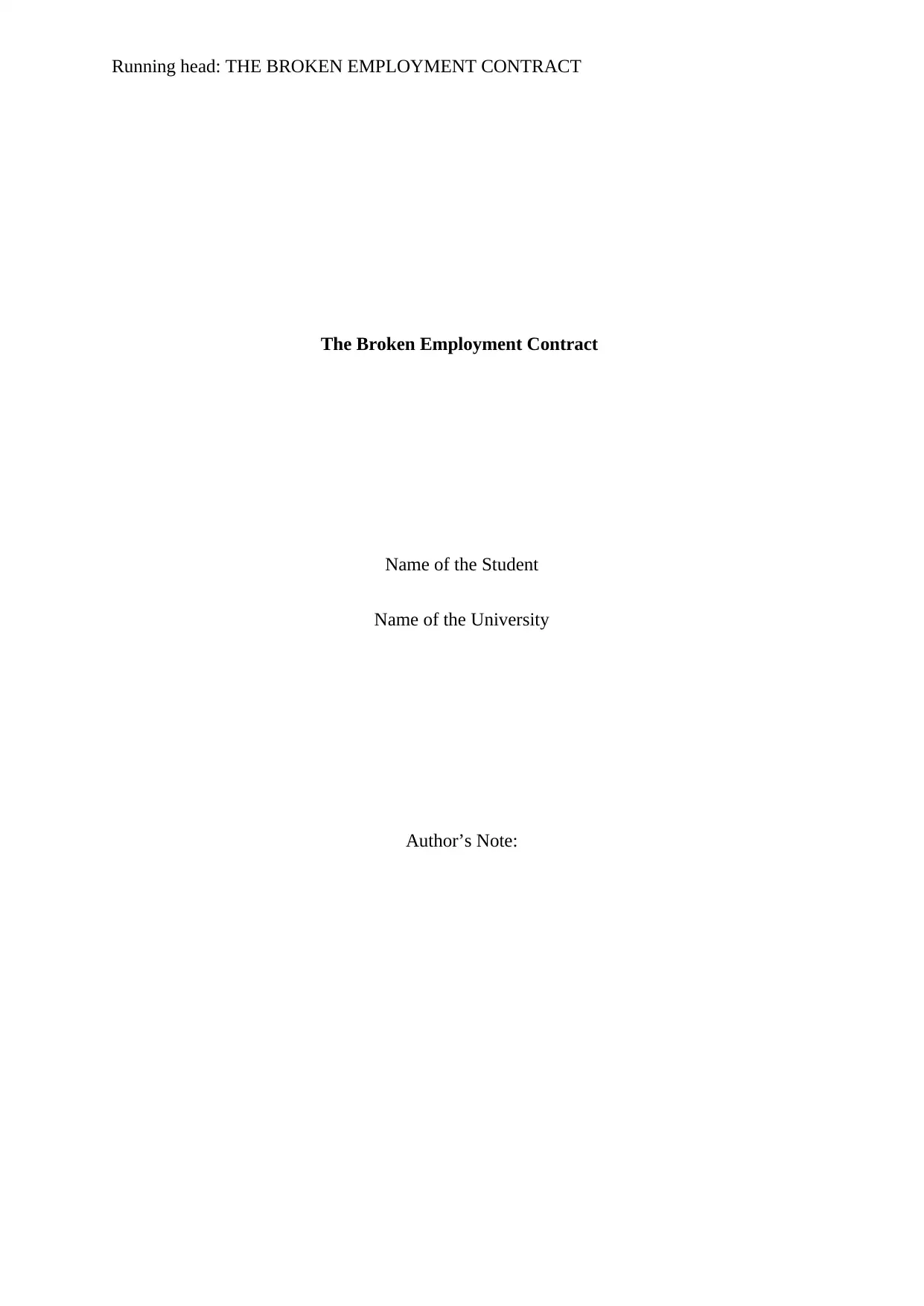
Running head: THE BROKEN EMPLOYMENT CONTRACT
The Broken Employment Contract
Name of the Student
Name of the University
Author’s Note:
The Broken Employment Contract
Name of the Student
Name of the University
Author’s Note:
Paraphrase This Document
Need a fresh take? Get an instant paraphrase of this document with our AI Paraphraser
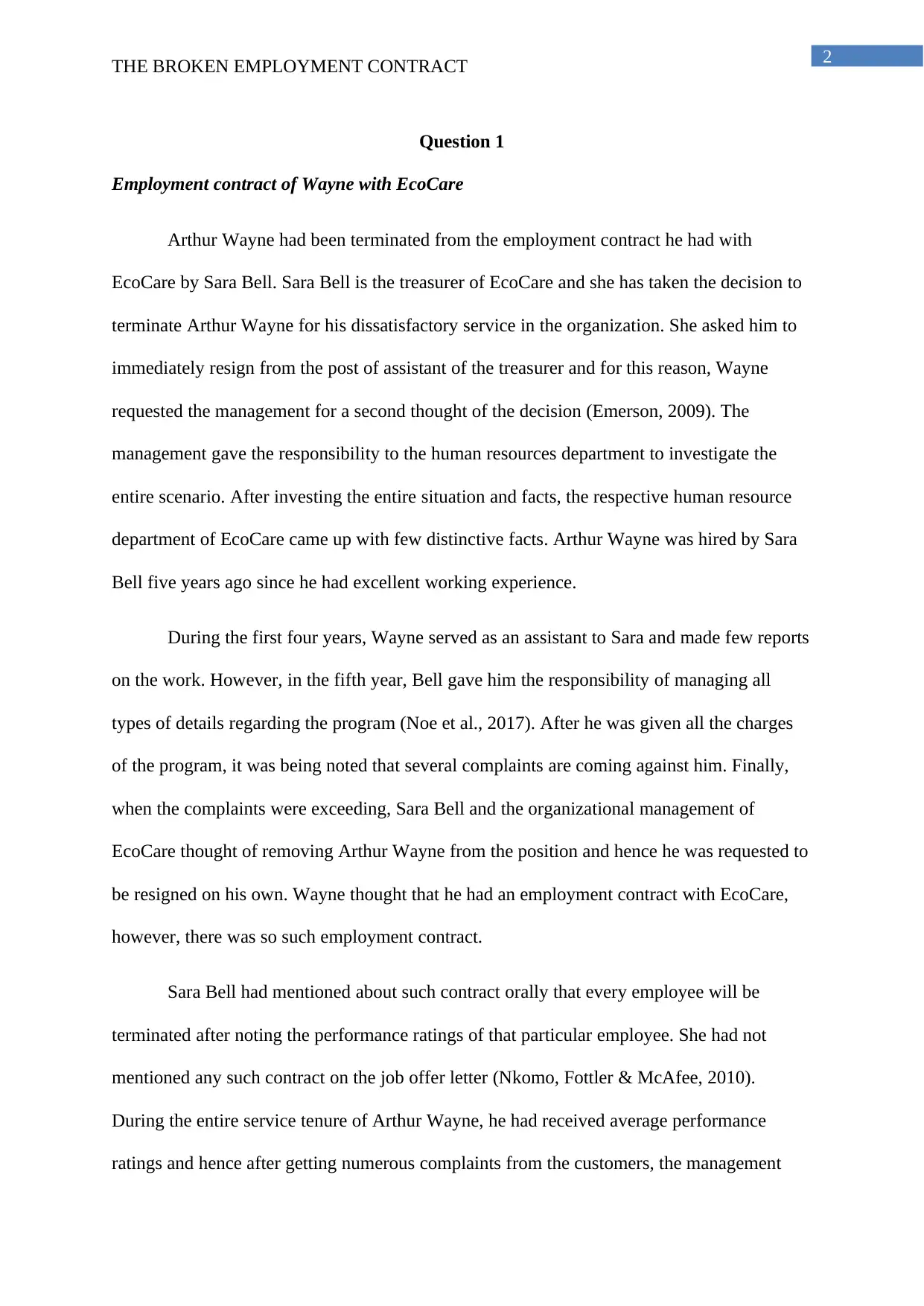
2
THE BROKEN EMPLOYMENT CONTRACT
Question 1
Employment contract of Wayne with EcoCare
Arthur Wayne had been terminated from the employment contract he had with
EcoCare by Sara Bell. Sara Bell is the treasurer of EcoCare and she has taken the decision to
terminate Arthur Wayne for his dissatisfactory service in the organization. She asked him to
immediately resign from the post of assistant of the treasurer and for this reason, Wayne
requested the management for a second thought of the decision (Emerson, 2009). The
management gave the responsibility to the human resources department to investigate the
entire scenario. After investing the entire situation and facts, the respective human resource
department of EcoCare came up with few distinctive facts. Arthur Wayne was hired by Sara
Bell five years ago since he had excellent working experience.
During the first four years, Wayne served as an assistant to Sara and made few reports
on the work. However, in the fifth year, Bell gave him the responsibility of managing all
types of details regarding the program (Noe et al., 2017). After he was given all the charges
of the program, it was being noted that several complaints are coming against him. Finally,
when the complaints were exceeding, Sara Bell and the organizational management of
EcoCare thought of removing Arthur Wayne from the position and hence he was requested to
be resigned on his own. Wayne thought that he had an employment contract with EcoCare,
however, there was so such employment contract.
Sara Bell had mentioned about such contract orally that every employee will be
terminated after noting the performance ratings of that particular employee. She had not
mentioned any such contract on the job offer letter (Nkomo, Fottler & McAfee, 2010).
During the entire service tenure of Arthur Wayne, he had received average performance
ratings and hence after getting numerous complaints from the customers, the management
THE BROKEN EMPLOYMENT CONTRACT
Question 1
Employment contract of Wayne with EcoCare
Arthur Wayne had been terminated from the employment contract he had with
EcoCare by Sara Bell. Sara Bell is the treasurer of EcoCare and she has taken the decision to
terminate Arthur Wayne for his dissatisfactory service in the organization. She asked him to
immediately resign from the post of assistant of the treasurer and for this reason, Wayne
requested the management for a second thought of the decision (Emerson, 2009). The
management gave the responsibility to the human resources department to investigate the
entire scenario. After investing the entire situation and facts, the respective human resource
department of EcoCare came up with few distinctive facts. Arthur Wayne was hired by Sara
Bell five years ago since he had excellent working experience.
During the first four years, Wayne served as an assistant to Sara and made few reports
on the work. However, in the fifth year, Bell gave him the responsibility of managing all
types of details regarding the program (Noe et al., 2017). After he was given all the charges
of the program, it was being noted that several complaints are coming against him. Finally,
when the complaints were exceeding, Sara Bell and the organizational management of
EcoCare thought of removing Arthur Wayne from the position and hence he was requested to
be resigned on his own. Wayne thought that he had an employment contract with EcoCare,
however, there was so such employment contract.
Sara Bell had mentioned about such contract orally that every employee will be
terminated after noting the performance ratings of that particular employee. She had not
mentioned any such contract on the job offer letter (Nkomo, Fottler & McAfee, 2010).
During the entire service tenure of Arthur Wayne, he had received average performance
ratings and hence after getting numerous complaints from the customers, the management
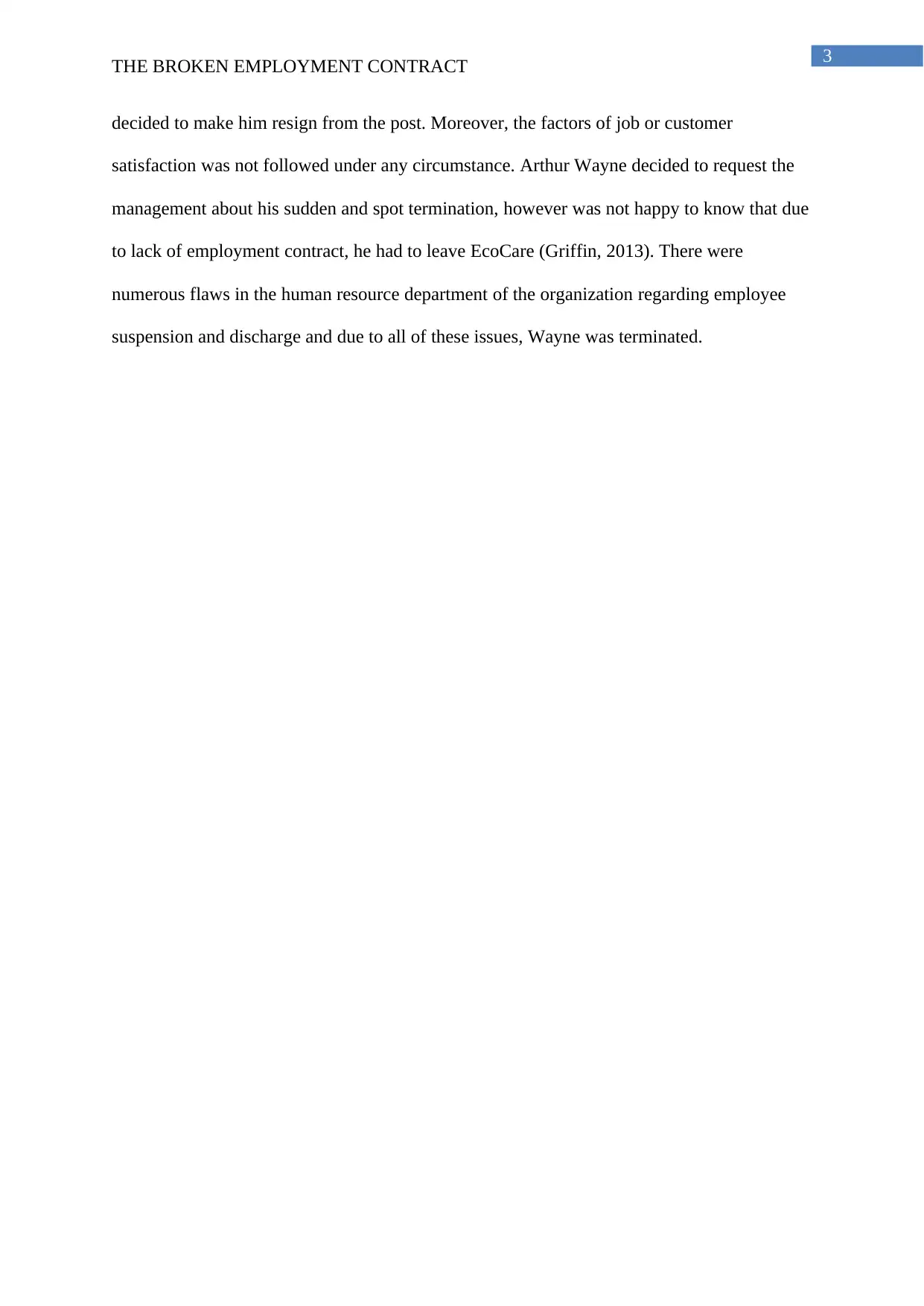
3
THE BROKEN EMPLOYMENT CONTRACT
decided to make him resign from the post. Moreover, the factors of job or customer
satisfaction was not followed under any circumstance. Arthur Wayne decided to request the
management about his sudden and spot termination, however was not happy to know that due
to lack of employment contract, he had to leave EcoCare (Griffin, 2013). There were
numerous flaws in the human resource department of the organization regarding employee
suspension and discharge and due to all of these issues, Wayne was terminated.
THE BROKEN EMPLOYMENT CONTRACT
decided to make him resign from the post. Moreover, the factors of job or customer
satisfaction was not followed under any circumstance. Arthur Wayne decided to request the
management about his sudden and spot termination, however was not happy to know that due
to lack of employment contract, he had to leave EcoCare (Griffin, 2013). There were
numerous flaws in the human resource department of the organization regarding employee
suspension and discharge and due to all of these issues, Wayne was terminated.
⊘ This is a preview!⊘
Do you want full access?
Subscribe today to unlock all pages.

Trusted by 1+ million students worldwide
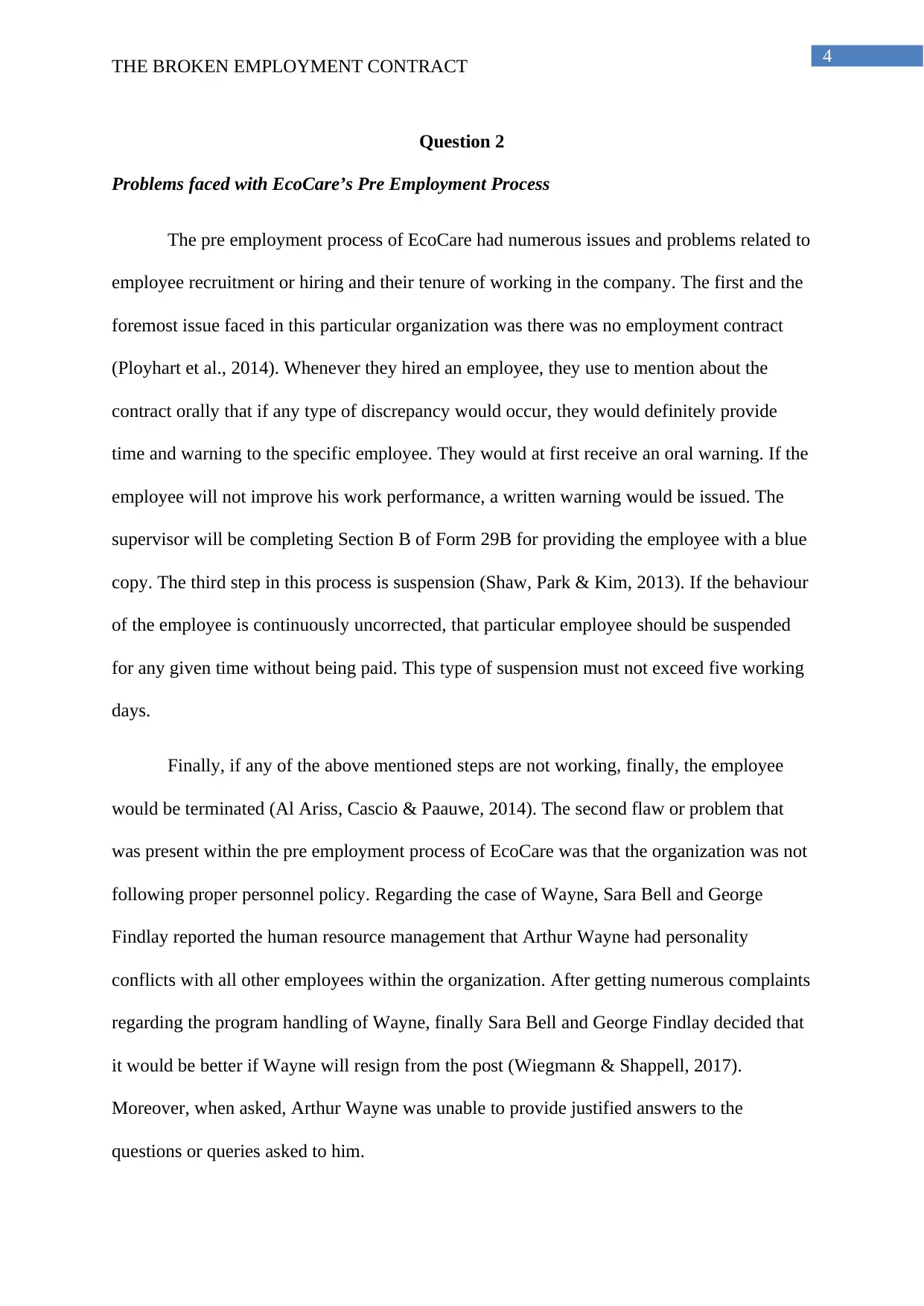
4
THE BROKEN EMPLOYMENT CONTRACT
Question 2
Problems faced with EcoCare’s Pre Employment Process
The pre employment process of EcoCare had numerous issues and problems related to
employee recruitment or hiring and their tenure of working in the company. The first and the
foremost issue faced in this particular organization was there was no employment contract
(Ployhart et al., 2014). Whenever they hired an employee, they use to mention about the
contract orally that if any type of discrepancy would occur, they would definitely provide
time and warning to the specific employee. They would at first receive an oral warning. If the
employee will not improve his work performance, a written warning would be issued. The
supervisor will be completing Section B of Form 29B for providing the employee with a blue
copy. The third step in this process is suspension (Shaw, Park & Kim, 2013). If the behaviour
of the employee is continuously uncorrected, that particular employee should be suspended
for any given time without being paid. This type of suspension must not exceed five working
days.
Finally, if any of the above mentioned steps are not working, finally, the employee
would be terminated (Al Ariss, Cascio & Paauwe, 2014). The second flaw or problem that
was present within the pre employment process of EcoCare was that the organization was not
following proper personnel policy. Regarding the case of Wayne, Sara Bell and George
Findlay reported the human resource management that Arthur Wayne had personality
conflicts with all other employees within the organization. After getting numerous complaints
regarding the program handling of Wayne, finally Sara Bell and George Findlay decided that
it would be better if Wayne will resign from the post (Wiegmann & Shappell, 2017).
Moreover, when asked, Arthur Wayne was unable to provide justified answers to the
questions or queries asked to him.
THE BROKEN EMPLOYMENT CONTRACT
Question 2
Problems faced with EcoCare’s Pre Employment Process
The pre employment process of EcoCare had numerous issues and problems related to
employee recruitment or hiring and their tenure of working in the company. The first and the
foremost issue faced in this particular organization was there was no employment contract
(Ployhart et al., 2014). Whenever they hired an employee, they use to mention about the
contract orally that if any type of discrepancy would occur, they would definitely provide
time and warning to the specific employee. They would at first receive an oral warning. If the
employee will not improve his work performance, a written warning would be issued. The
supervisor will be completing Section B of Form 29B for providing the employee with a blue
copy. The third step in this process is suspension (Shaw, Park & Kim, 2013). If the behaviour
of the employee is continuously uncorrected, that particular employee should be suspended
for any given time without being paid. This type of suspension must not exceed five working
days.
Finally, if any of the above mentioned steps are not working, finally, the employee
would be terminated (Al Ariss, Cascio & Paauwe, 2014). The second flaw or problem that
was present within the pre employment process of EcoCare was that the organization was not
following proper personnel policy. Regarding the case of Wayne, Sara Bell and George
Findlay reported the human resource management that Arthur Wayne had personality
conflicts with all other employees within the organization. After getting numerous complaints
regarding the program handling of Wayne, finally Sara Bell and George Findlay decided that
it would be better if Wayne will resign from the post (Wiegmann & Shappell, 2017).
Moreover, when asked, Arthur Wayne was unable to provide justified answers to the
questions or queries asked to him.
Paraphrase This Document
Need a fresh take? Get an instant paraphrase of this document with our AI Paraphraser
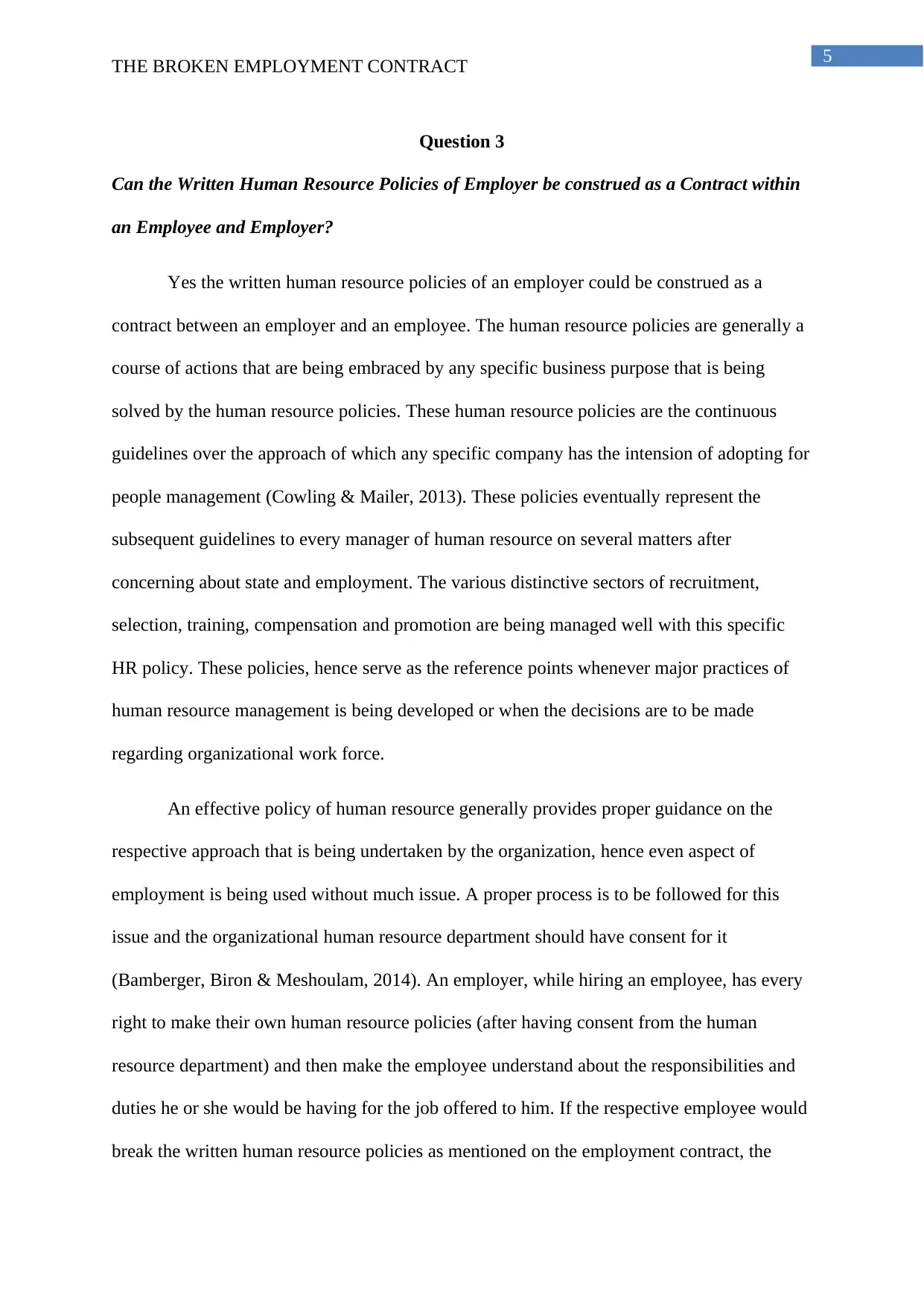
5
THE BROKEN EMPLOYMENT CONTRACT
Question 3
Can the Written Human Resource Policies of Employer be construed as a Contract within
an Employee and Employer?
Yes the written human resource policies of an employer could be construed as a
contract between an employer and an employee. The human resource policies are generally a
course of actions that are being embraced by any specific business purpose that is being
solved by the human resource policies. These human resource policies are the continuous
guidelines over the approach of which any specific company has the intension of adopting for
people management (Cowling & Mailer, 2013). These policies eventually represent the
subsequent guidelines to every manager of human resource on several matters after
concerning about state and employment. The various distinctive sectors of recruitment,
selection, training, compensation and promotion are being managed well with this specific
HR policy. These policies, hence serve as the reference points whenever major practices of
human resource management is being developed or when the decisions are to be made
regarding organizational work force.
An effective policy of human resource generally provides proper guidance on the
respective approach that is being undertaken by the organization, hence even aspect of
employment is being used without much issue. A proper process is to be followed for this
issue and the organizational human resource department should have consent for it
(Bamberger, Biron & Meshoulam, 2014). An employer, while hiring an employee, has every
right to make their own human resource policies (after having consent from the human
resource department) and then make the employee understand about the responsibilities and
duties he or she would be having for the job offered to him. If the respective employee would
break the written human resource policies as mentioned on the employment contract, the
THE BROKEN EMPLOYMENT CONTRACT
Question 3
Can the Written Human Resource Policies of Employer be construed as a Contract within
an Employee and Employer?
Yes the written human resource policies of an employer could be construed as a
contract between an employer and an employee. The human resource policies are generally a
course of actions that are being embraced by any specific business purpose that is being
solved by the human resource policies. These human resource policies are the continuous
guidelines over the approach of which any specific company has the intension of adopting for
people management (Cowling & Mailer, 2013). These policies eventually represent the
subsequent guidelines to every manager of human resource on several matters after
concerning about state and employment. The various distinctive sectors of recruitment,
selection, training, compensation and promotion are being managed well with this specific
HR policy. These policies, hence serve as the reference points whenever major practices of
human resource management is being developed or when the decisions are to be made
regarding organizational work force.
An effective policy of human resource generally provides proper guidance on the
respective approach that is being undertaken by the organization, hence even aspect of
employment is being used without much issue. A proper process is to be followed for this
issue and the organizational human resource department should have consent for it
(Bamberger, Biron & Meshoulam, 2014). An employer, while hiring an employee, has every
right to make their own human resource policies (after having consent from the human
resource department) and then make the employee understand about the responsibilities and
duties he or she would be having for the job offered to him. If the respective employee would
break the written human resource policies as mentioned on the employment contract, the
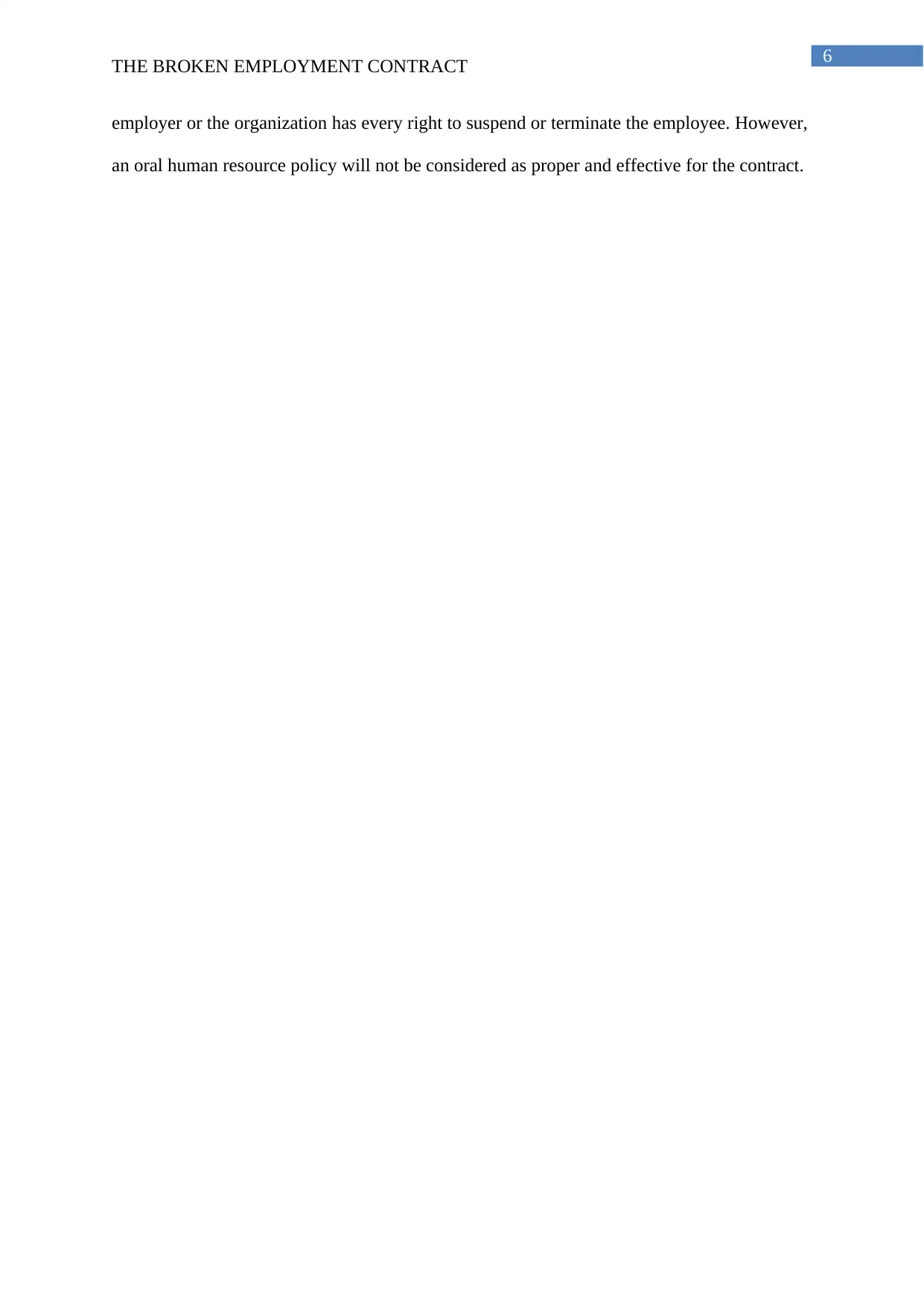
6
THE BROKEN EMPLOYMENT CONTRACT
employer or the organization has every right to suspend or terminate the employee. However,
an oral human resource policy will not be considered as proper and effective for the contract.
THE BROKEN EMPLOYMENT CONTRACT
employer or the organization has every right to suspend or terminate the employee. However,
an oral human resource policy will not be considered as proper and effective for the contract.
⊘ This is a preview!⊘
Do you want full access?
Subscribe today to unlock all pages.

Trusted by 1+ million students worldwide
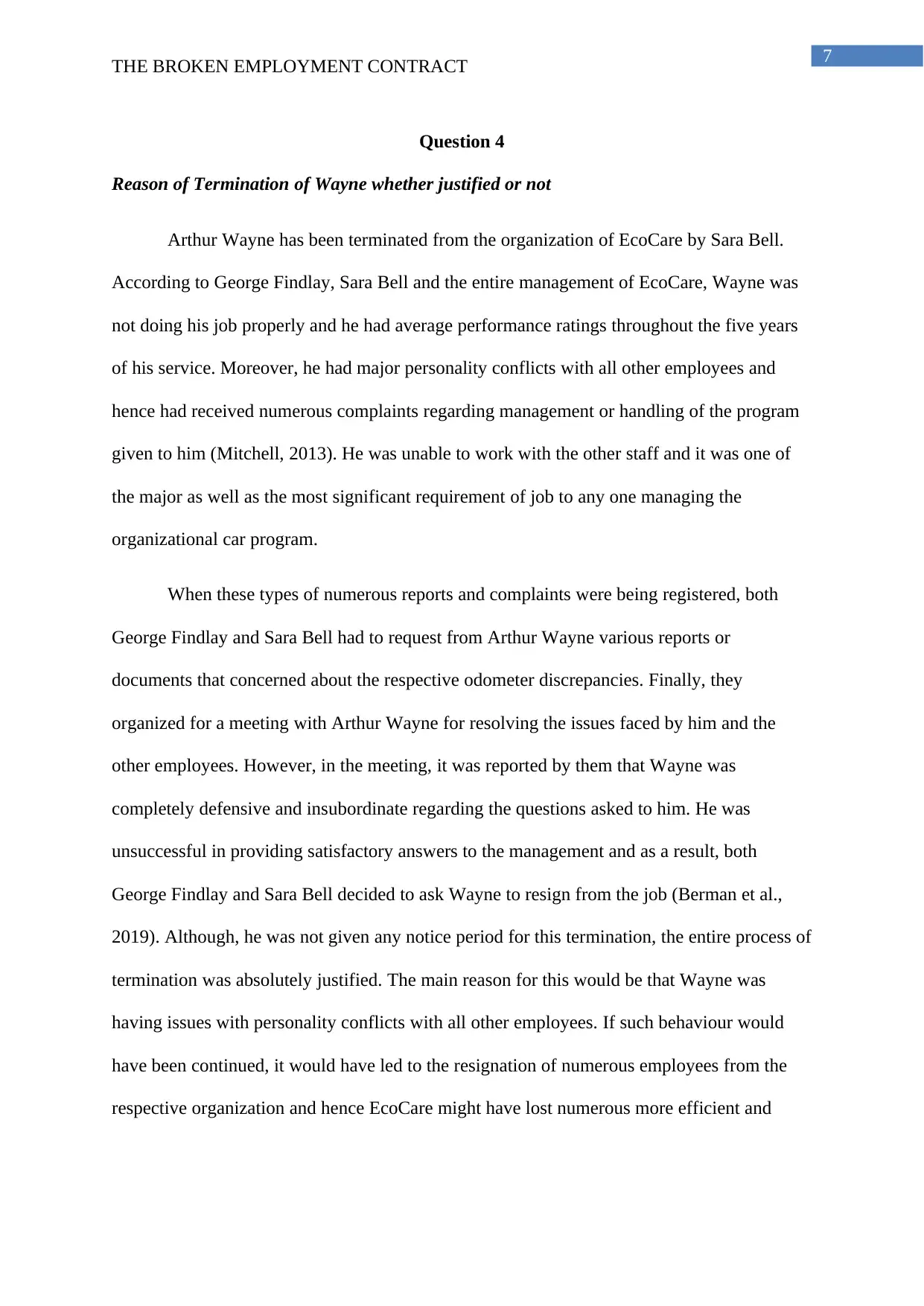
7
THE BROKEN EMPLOYMENT CONTRACT
Question 4
Reason of Termination of Wayne whether justified or not
Arthur Wayne has been terminated from the organization of EcoCare by Sara Bell.
According to George Findlay, Sara Bell and the entire management of EcoCare, Wayne was
not doing his job properly and he had average performance ratings throughout the five years
of his service. Moreover, he had major personality conflicts with all other employees and
hence had received numerous complaints regarding management or handling of the program
given to him (Mitchell, 2013). He was unable to work with the other staff and it was one of
the major as well as the most significant requirement of job to any one managing the
organizational car program.
When these types of numerous reports and complaints were being registered, both
George Findlay and Sara Bell had to request from Arthur Wayne various reports or
documents that concerned about the respective odometer discrepancies. Finally, they
organized for a meeting with Arthur Wayne for resolving the issues faced by him and the
other employees. However, in the meeting, it was reported by them that Wayne was
completely defensive and insubordinate regarding the questions asked to him. He was
unsuccessful in providing satisfactory answers to the management and as a result, both
George Findlay and Sara Bell decided to ask Wayne to resign from the job (Berman et al.,
2019). Although, he was not given any notice period for this termination, the entire process of
termination was absolutely justified. The main reason for this would be that Wayne was
having issues with personality conflicts with all other employees. If such behaviour would
have been continued, it would have led to the resignation of numerous employees from the
respective organization and hence EcoCare might have lost numerous more efficient and
THE BROKEN EMPLOYMENT CONTRACT
Question 4
Reason of Termination of Wayne whether justified or not
Arthur Wayne has been terminated from the organization of EcoCare by Sara Bell.
According to George Findlay, Sara Bell and the entire management of EcoCare, Wayne was
not doing his job properly and he had average performance ratings throughout the five years
of his service. Moreover, he had major personality conflicts with all other employees and
hence had received numerous complaints regarding management or handling of the program
given to him (Mitchell, 2013). He was unable to work with the other staff and it was one of
the major as well as the most significant requirement of job to any one managing the
organizational car program.
When these types of numerous reports and complaints were being registered, both
George Findlay and Sara Bell had to request from Arthur Wayne various reports or
documents that concerned about the respective odometer discrepancies. Finally, they
organized for a meeting with Arthur Wayne for resolving the issues faced by him and the
other employees. However, in the meeting, it was reported by them that Wayne was
completely defensive and insubordinate regarding the questions asked to him. He was
unsuccessful in providing satisfactory answers to the management and as a result, both
George Findlay and Sara Bell decided to ask Wayne to resign from the job (Berman et al.,
2019). Although, he was not given any notice period for this termination, the entire process of
termination was absolutely justified. The main reason for this would be that Wayne was
having issues with personality conflicts with all other employees. If such behaviour would
have been continued, it would have led to the resignation of numerous employees from the
respective organization and hence EcoCare might have lost numerous more efficient and
Paraphrase This Document
Need a fresh take? Get an instant paraphrase of this document with our AI Paraphraser
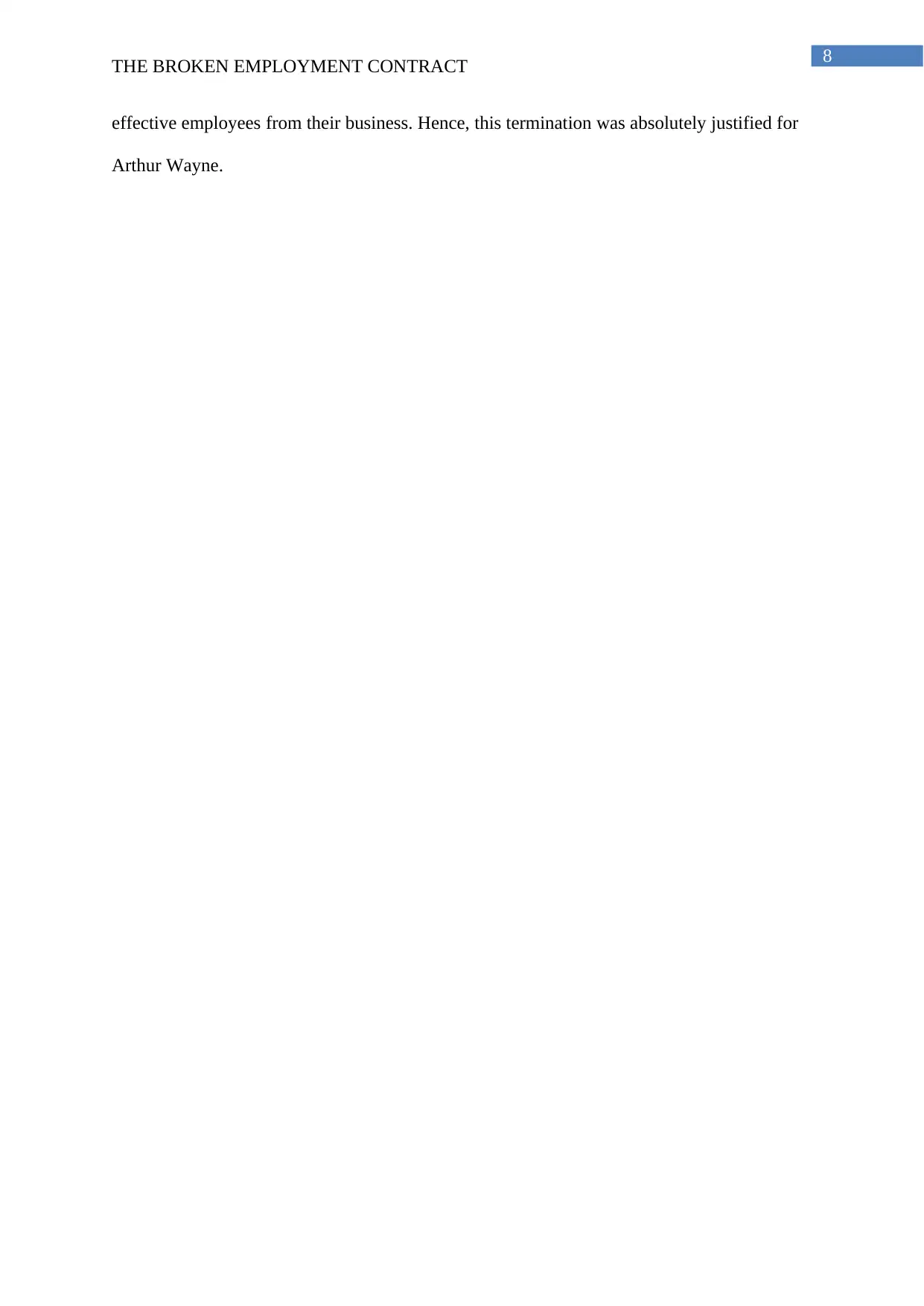
8
THE BROKEN EMPLOYMENT CONTRACT
effective employees from their business. Hence, this termination was absolutely justified for
Arthur Wayne.
THE BROKEN EMPLOYMENT CONTRACT
effective employees from their business. Hence, this termination was absolutely justified for
Arthur Wayne.
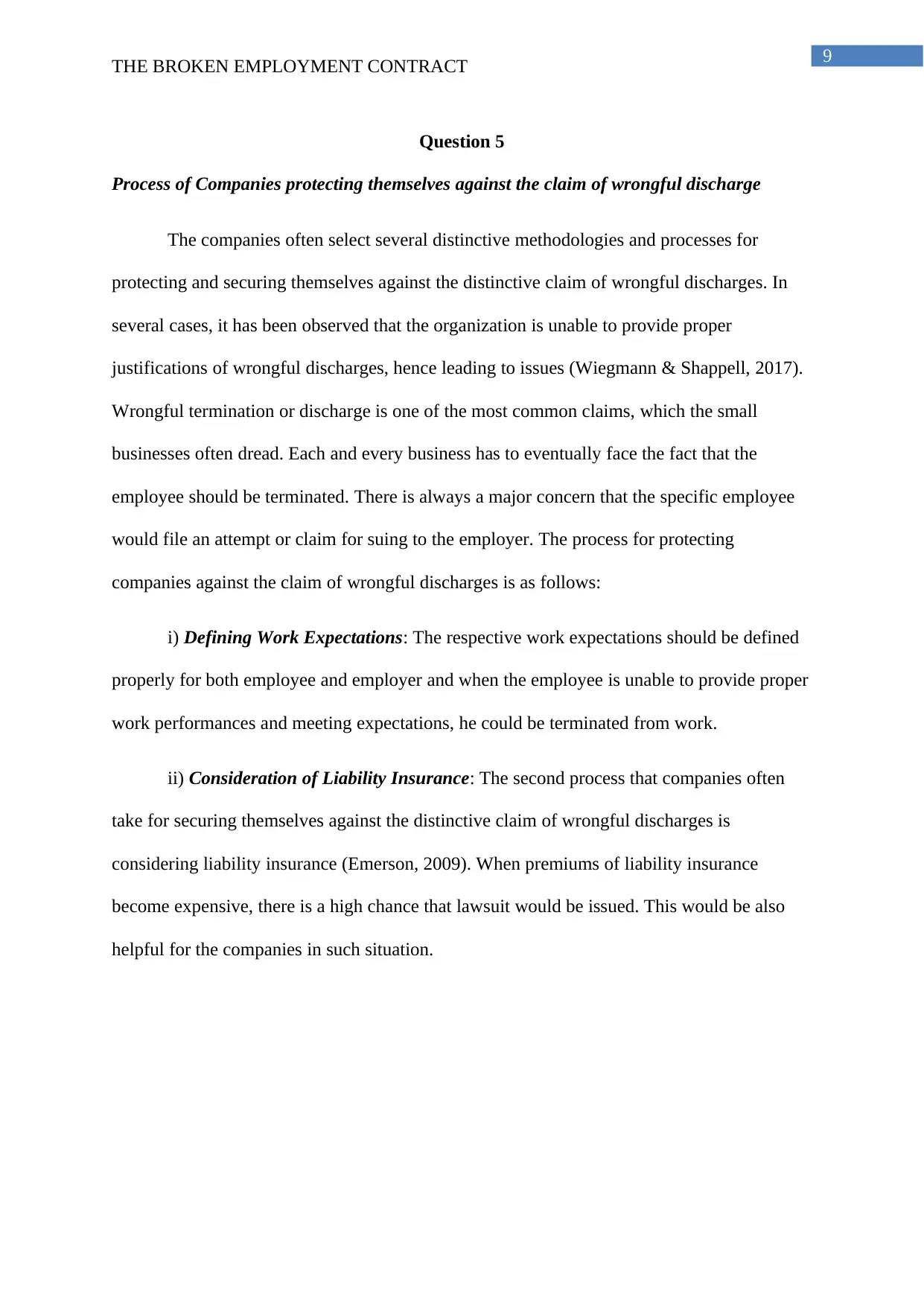
9
THE BROKEN EMPLOYMENT CONTRACT
Question 5
Process of Companies protecting themselves against the claim of wrongful discharge
The companies often select several distinctive methodologies and processes for
protecting and securing themselves against the distinctive claim of wrongful discharges. In
several cases, it has been observed that the organization is unable to provide proper
justifications of wrongful discharges, hence leading to issues (Wiegmann & Shappell, 2017).
Wrongful termination or discharge is one of the most common claims, which the small
businesses often dread. Each and every business has to eventually face the fact that the
employee should be terminated. There is always a major concern that the specific employee
would file an attempt or claim for suing to the employer. The process for protecting
companies against the claim of wrongful discharges is as follows:
i) Defining Work Expectations: The respective work expectations should be defined
properly for both employee and employer and when the employee is unable to provide proper
work performances and meeting expectations, he could be terminated from work.
ii) Consideration of Liability Insurance: The second process that companies often
take for securing themselves against the distinctive claim of wrongful discharges is
considering liability insurance (Emerson, 2009). When premiums of liability insurance
become expensive, there is a high chance that lawsuit would be issued. This would be also
helpful for the companies in such situation.
THE BROKEN EMPLOYMENT CONTRACT
Question 5
Process of Companies protecting themselves against the claim of wrongful discharge
The companies often select several distinctive methodologies and processes for
protecting and securing themselves against the distinctive claim of wrongful discharges. In
several cases, it has been observed that the organization is unable to provide proper
justifications of wrongful discharges, hence leading to issues (Wiegmann & Shappell, 2017).
Wrongful termination or discharge is one of the most common claims, which the small
businesses often dread. Each and every business has to eventually face the fact that the
employee should be terminated. There is always a major concern that the specific employee
would file an attempt or claim for suing to the employer. The process for protecting
companies against the claim of wrongful discharges is as follows:
i) Defining Work Expectations: The respective work expectations should be defined
properly for both employee and employer and when the employee is unable to provide proper
work performances and meeting expectations, he could be terminated from work.
ii) Consideration of Liability Insurance: The second process that companies often
take for securing themselves against the distinctive claim of wrongful discharges is
considering liability insurance (Emerson, 2009). When premiums of liability insurance
become expensive, there is a high chance that lawsuit would be issued. This would be also
helpful for the companies in such situation.
⊘ This is a preview!⊘
Do you want full access?
Subscribe today to unlock all pages.

Trusted by 1+ million students worldwide
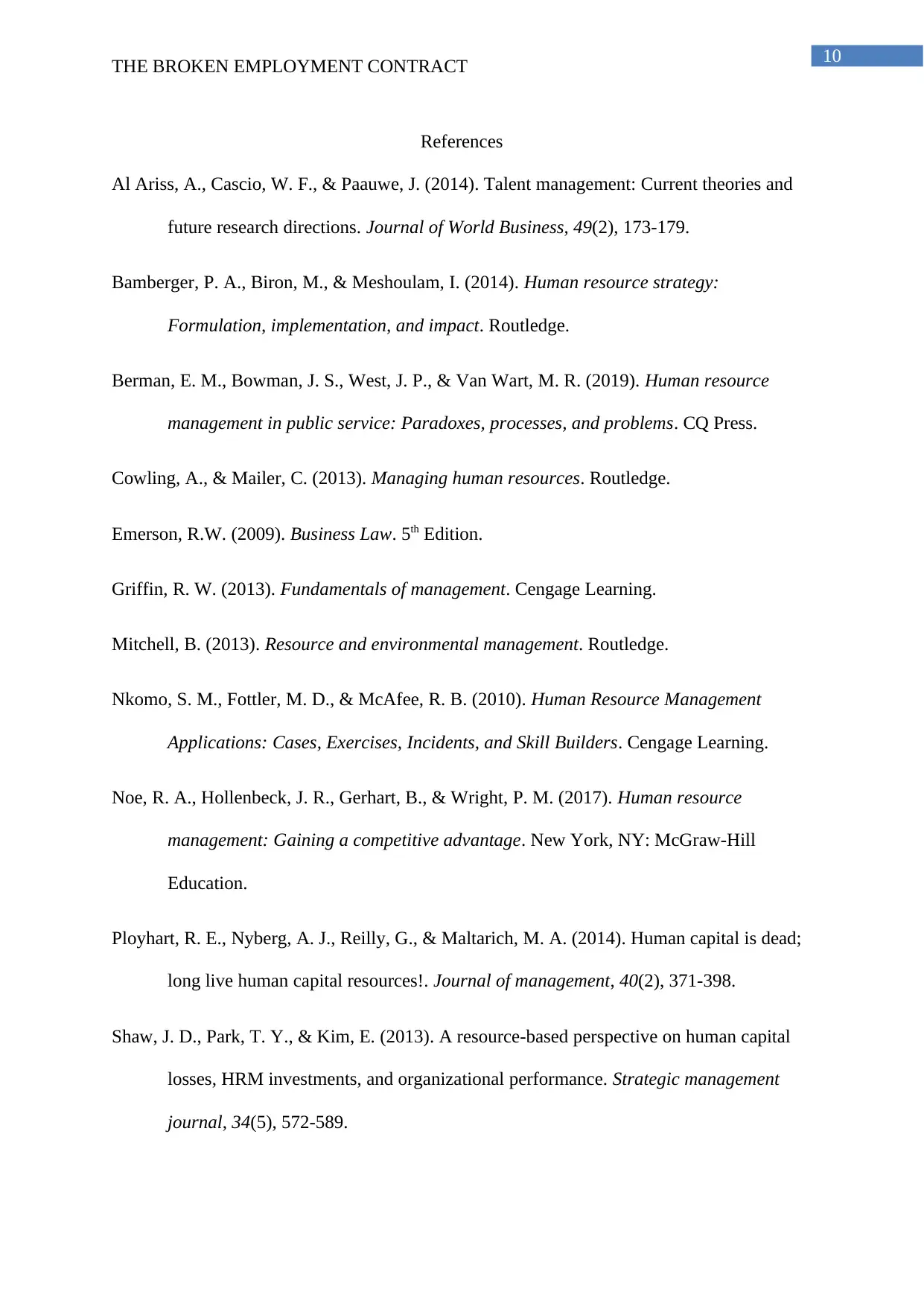
10
THE BROKEN EMPLOYMENT CONTRACT
References
Al Ariss, A., Cascio, W. F., & Paauwe, J. (2014). Talent management: Current theories and
future research directions. Journal of World Business, 49(2), 173-179.
Bamberger, P. A., Biron, M., & Meshoulam, I. (2014). Human resource strategy:
Formulation, implementation, and impact. Routledge.
Berman, E. M., Bowman, J. S., West, J. P., & Van Wart, M. R. (2019). Human resource
management in public service: Paradoxes, processes, and problems. CQ Press.
Cowling, A., & Mailer, C. (2013). Managing human resources. Routledge.
Emerson, R.W. (2009). Business Law. 5th Edition.
Griffin, R. W. (2013). Fundamentals of management. Cengage Learning.
Mitchell, B. (2013). Resource and environmental management. Routledge.
Nkomo, S. M., Fottler, M. D., & McAfee, R. B. (2010). Human Resource Management
Applications: Cases, Exercises, Incidents, and Skill Builders. Cengage Learning.
Noe, R. A., Hollenbeck, J. R., Gerhart, B., & Wright, P. M. (2017). Human resource
management: Gaining a competitive advantage. New York, NY: McGraw-Hill
Education.
Ployhart, R. E., Nyberg, A. J., Reilly, G., & Maltarich, M. A. (2014). Human capital is dead;
long live human capital resources!. Journal of management, 40(2), 371-398.
Shaw, J. D., Park, T. Y., & Kim, E. (2013). A resource‐based perspective on human capital
losses, HRM investments, and organizational performance. Strategic management
journal, 34(5), 572-589.
THE BROKEN EMPLOYMENT CONTRACT
References
Al Ariss, A., Cascio, W. F., & Paauwe, J. (2014). Talent management: Current theories and
future research directions. Journal of World Business, 49(2), 173-179.
Bamberger, P. A., Biron, M., & Meshoulam, I. (2014). Human resource strategy:
Formulation, implementation, and impact. Routledge.
Berman, E. M., Bowman, J. S., West, J. P., & Van Wart, M. R. (2019). Human resource
management in public service: Paradoxes, processes, and problems. CQ Press.
Cowling, A., & Mailer, C. (2013). Managing human resources. Routledge.
Emerson, R.W. (2009). Business Law. 5th Edition.
Griffin, R. W. (2013). Fundamentals of management. Cengage Learning.
Mitchell, B. (2013). Resource and environmental management. Routledge.
Nkomo, S. M., Fottler, M. D., & McAfee, R. B. (2010). Human Resource Management
Applications: Cases, Exercises, Incidents, and Skill Builders. Cengage Learning.
Noe, R. A., Hollenbeck, J. R., Gerhart, B., & Wright, P. M. (2017). Human resource
management: Gaining a competitive advantage. New York, NY: McGraw-Hill
Education.
Ployhart, R. E., Nyberg, A. J., Reilly, G., & Maltarich, M. A. (2014). Human capital is dead;
long live human capital resources!. Journal of management, 40(2), 371-398.
Shaw, J. D., Park, T. Y., & Kim, E. (2013). A resource‐based perspective on human capital
losses, HRM investments, and organizational performance. Strategic management
journal, 34(5), 572-589.
Paraphrase This Document
Need a fresh take? Get an instant paraphrase of this document with our AI Paraphraser
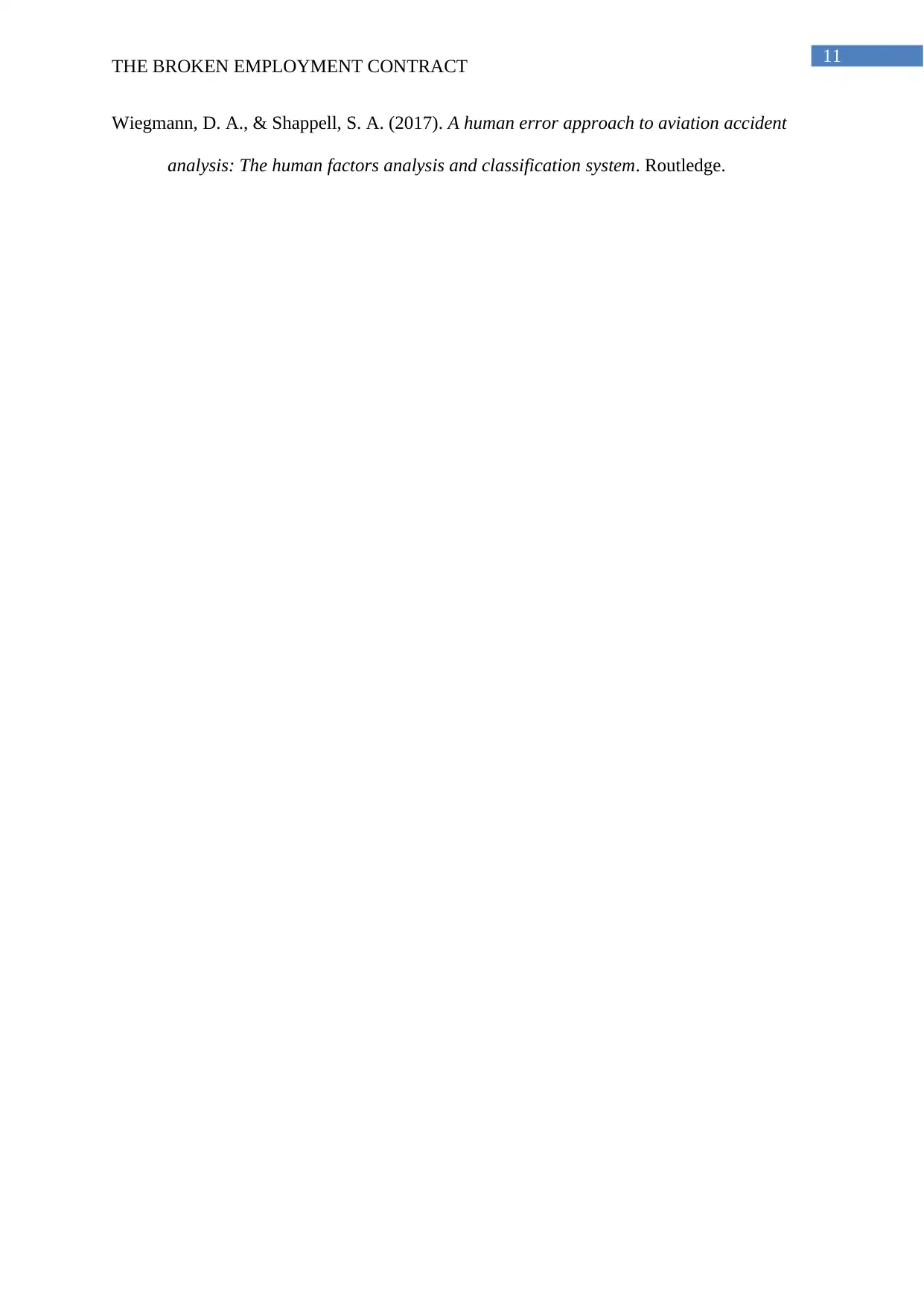
11
THE BROKEN EMPLOYMENT CONTRACT
Wiegmann, D. A., & Shappell, S. A. (2017). A human error approach to aviation accident
analysis: The human factors analysis and classification system. Routledge.
THE BROKEN EMPLOYMENT CONTRACT
Wiegmann, D. A., & Shappell, S. A. (2017). A human error approach to aviation accident
analysis: The human factors analysis and classification system. Routledge.
1 out of 11
Your All-in-One AI-Powered Toolkit for Academic Success.
+13062052269
info@desklib.com
Available 24*7 on WhatsApp / Email
![[object Object]](/_next/static/media/star-bottom.7253800d.svg)
Unlock your academic potential
Copyright © 2020–2025 A2Z Services. All Rights Reserved. Developed and managed by ZUCOL.